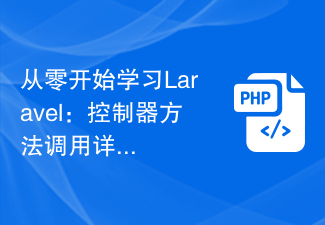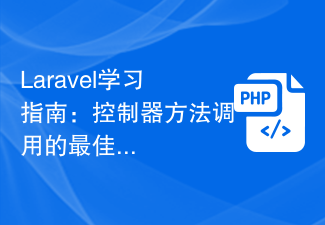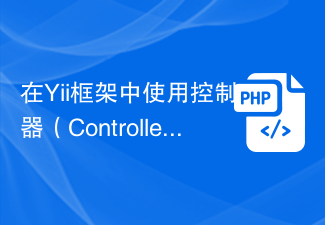 Backend Development
Backend Development PHP Tutorial
PHP Tutorial How to use controllers to handle file uploads and downloads in the Yii framework
How to use controllers to handle file uploads and downloads in the Yii frameworkHow to use controllers (Controllers) to handle file upload and download in the Yii framework
In many web applications, file upload and download are very common functions. In the Yii framework, we can handle file upload and download operations through controllers. This article will introduce how to use controllers in the Yii framework to upload and download files, and provide corresponding code examples.
1. File upload
File upload refers to the process of transferring files on the local computer to the server. In the Yii framework, we can use controllers to handle file upload operations. First, we need to create a controller to handle file uploads.
- Create a controller
In the Yii framework, we can create a controller through the following command:
yii gii/controller UploadController
This will be done in Create a controller file named UploadController in the controllers directory.
- Implementing the file upload method
In the UploadController controller file, we can implement an actionUpload method to process the file Upload operation. The following is an example of a simple file upload method:
public function actionUpload()
{
// 获取上传文件
$file = UploadedFile::getInstanceByName('file');
// 定义上传文件存储路径
$uploadPath = Yii::getAlias('@webroot/uploads/');
// 如果上传目录不存在,则创建目录
if (!is_dir($uploadPath)) {
mkdir($uploadPath, 0777, true);
}
// 生成唯一的文件名
$fileName = uniqid() . '.' . $file->extension;
// 将文件保存到上传目录
$file->saveAs($uploadPath . $fileName);
// 返回上传成功的文件路径
return $uploadPath . $fileName;
}In the above code, we first obtain the instance of the uploaded file through the UploadedFile::getInstanceByName method. We then defined the storage path for the uploaded files and ensured that the path existed. Next, we generated a unique filename and saved the uploaded file to the upload path on the server. Finally, we return the file path of the successfully uploaded file.
- Configuring Routing Rules
To make the file upload method available, we need to add a routing rule in the application's routing configuration file. In the web.php file in the config directory, we can add the following routing rules:
[
'POST upload' => 'upload/upload',
]In this way, when we access the upload route And when sending a request with the POST method, the actionUpload method of UploadController will be executed.
2. File Download
File downloading refers to the process of sending files on the server to the local computer. In the Yii framework, we can use controllers to handle file download operations. Here is an example of a simple file download method:
- Create Controller
Similar to file upload, we need to create a controller in Yii framework to handle files Download operation.
- Implementing the file download method
In the controller file, we can implement an actionDownload method to handle the file download operation. Here is an example of a simple file download method:
public function actionDownload($filename)
{
// 定义文件路径
$filePath = Yii::getAlias('@webroot/uploads/') . $filename;
// 检查文件是否存在
if (!is_file($filePath)) {
throw new yiiwebNotFoundHttpException('The file does not exist.');
}
// 使用Yii的response组件发送文件到客户端
return Yii::$app->response->sendFile($filePath, $filename);
}In the above code, we first define the path of the file to be downloaded. Then we check if the file exists. If the file does not exist, we throw a 404 error. Finally, we use the response component of the Yii framework to send the file to the client to implement the file download function.
- Configuring Routing Rules
To make the file download method available, we need to add a routing rule in the application's routing configuration file. In the web.php file in the config directory, we can add the following routing rules:
[
'GET download/<filename:[wd_]+.[wd]{2,4}>' => 'download/download',
]In this way, when we access download/filenameWhen routing, the actionDownload method of DownloadController will be executed and the file name will be passed as a parameter.
Summary
This article introduces the method of using controllers to handle file uploads and downloads in the Yii framework, and provides corresponding code examples. By creating a controller and implementing the corresponding methods, we can easily implement file upload and download functions in the Yii framework. Hope this article helps you!
The above is the detailed content of How to use controllers to handle file uploads and downloads in the Yii framework. For more information, please follow other related articles on the PHP Chinese website!
 Windows 11 上正确校准 Xbox One 控制器的方法Sep 21, 2023 pm 09:09 PM
Windows 11 上正确校准 Xbox One 控制器的方法Sep 21, 2023 pm 09:09 PM由于Windows已成为首选的游戏平台,因此确定其面向游戏的功能就显得尤为重要。其中之一是能够在Windows11上校准XboxOne控制器。借助内置的手动校准,您可以摆脱漂移、随机移动或性能问题,并有效地对齐X、Y和Z轴。如果可用选项不起作用,您可以随时使用第三方XboxOne控制器校准工具。让我们来了解一下!如何在Windows11上校准我的Xbox控制器?在继续操作之前,请确保将控制器连接到电脑并更新XboxOne控制器的驱动程序。当您使用它时,还要安装任何可用的固件更新。1.使用Wind
 从零开始学习Laravel:控制器方法调用详解Mar 10, 2024 pm 05:03 PM
从零开始学习Laravel:控制器方法调用详解Mar 10, 2024 pm 05:03 PM从零开始学习Laravel:控制器方法调用详解在Laravel的开发中,控制器是一个非常重要的概念。控制器起到了连接模型和视图的桥梁作用,负责处理来自路由的请求,并返回相应的数据给视图展示。控制器中的方法可以被路由调用,这篇文章将详细介绍如何编写并调用控制器中的方法,同时会提供具体的代码示例。首先,我们需要创建一个控制器。可以使用Artisan命令行工具来生
 什么叫laravel控制器Jan 14, 2023 am 11:16 AM
什么叫laravel控制器Jan 14, 2023 am 11:16 AM在laravel中,控制器(Controller)是一个类,用于实现一定的功能;控制器能将相关的请求处理逻辑组成一个单独的类。控制器中存放中一些方法,实现一定的功能,通过路由调用控制器,不再使用回调函数;控制器被存放在“app/Http/Controllers”目录中。
 php如何使用CodeIgniter4框架?May 31, 2023 pm 02:51 PM
php如何使用CodeIgniter4框架?May 31, 2023 pm 02:51 PMPHP是一种非常流行的编程语言,而CodeIgniter4是一种常用的PHP框架。在开发Web应用程序时,使用框架是非常有帮助的,它可以加速开发过程、提高代码质量、降低维护成本。本文将介绍如何使用CodeIgniter4框架。安装CodeIgniter4框架CodeIgniter4框架可以从官方网站(https://codeigniter.com/)下载。下
 Laravel学习指南:控制器方法调用的最佳实践Mar 11, 2024 am 08:27 AM
Laravel学习指南:控制器方法调用的最佳实践Mar 11, 2024 am 08:27 AM在Laravel学习指南中,控制器方法的调用是一个非常重要的主题。控制器扮演着连接路由和模型的桥梁的角色,在应用程序中起着至关重要的作用。本文将介绍控制器方法调用的最佳实践,并提供具体的代码示例帮助读者更好地理解。首先,让我们来了解控制器方法的基本结构。在Laravel中,控制器类通常存放在app/Http/Controllers目录下,每个控制器类包含多个
 在Yii框架中使用控制器(Controllers)处理Ajax请求的方法Jul 28, 2023 pm 07:37 PM
在Yii框架中使用控制器(Controllers)处理Ajax请求的方法Jul 28, 2023 pm 07:37 PM在Yii框架中,控制器(Controllers)扮演着处理请求的重要角色。除了处理常规的页面请求之外,控制器还可以用于处理Ajax请求。本文将介绍在Yii框架中处理Ajax请求的方法,并提供代码示例。在Yii框架中,处理Ajax请求可以通过以下步骤进行:第一步,创建一个控制器(Controller)类。可以通过继承Yii框架提供的基础控制器类yiiwebCo
 解决win10以太网控制器感叹号导致无法上网的方案Dec 23, 2023 pm 04:04 PM
解决win10以太网控制器感叹号导致无法上网的方案Dec 23, 2023 pm 04:04 PM很多网友在使用win10系统的过程中会发现,以太网控制器会出现感叹号的情况,这说明协处理器和以太网控制器驱动未正确安装,更新下驱动就可以了,可以在设备管理器中进行更新,接下来小编教你怎么操作。win10以太网控制器感叹号无法上网:1、首先右击桌面的“此电脑”,然后打开属性。2、然后去点击“设备管理器”,打开“控制器窗口”。3、之后去点击“网络适配器”,找到以下程序,右击“属性”。4、最后去选择“更新驱动程序”,下载安装最新版本,重启电脑即可。
 在Yii框架中使用控制器(Controllers)处理文件上传和下载的方法Jul 30, 2023 pm 12:25 PM
在Yii框架中使用控制器(Controllers)处理文件上传和下载的方法Jul 30, 2023 pm 12:25 PM在Yii框架中使用控制器(Controllers)处理文件上传和下载的方法在许多Web应用程序中,文件上传和下载是非常常见的功能。在Yii框架中,我们可以通过控制器(Controllers)来处理文件的上传和下载操作。本文将介绍如何在Yii框架中使用控制器来实现文件的上传和下载,并提供相应的代码示例。一、文件上传文件上传是指将本地计算机上的文件传输到服务器上


Hot AI Tools

Undresser.AI Undress
AI-powered app for creating realistic nude photos

AI Clothes Remover
Online AI tool for removing clothes from photos.

Undress AI Tool
Undress images for free

Clothoff.io
AI clothes remover

AI Hentai Generator
Generate AI Hentai for free.

Hot Article

Hot Tools

Safe Exam Browser
Safe Exam Browser is a secure browser environment for taking online exams securely. This software turns any computer into a secure workstation. It controls access to any utility and prevents students from using unauthorized resources.

PhpStorm Mac version
The latest (2018.2.1) professional PHP integrated development tool

ZendStudio 13.5.1 Mac
Powerful PHP integrated development environment

SublimeText3 Linux new version
SublimeText3 Linux latest version

Notepad++7.3.1
Easy-to-use and free code editor





